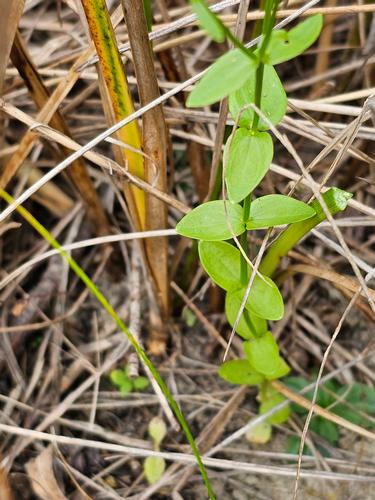Plants and Animals
Sabatia angularis Rosepink
Key Characteristics
Robust forb (up to 80 cm) of moist sandy shores; stems strongly 4-sided with narrow wings on the angles, bearing opposite broadly ovate leaves that clasp the stem; flowers rose-pink with 5 petals uniting to form a short floral tube.
Status and Rank
US Status: No Status/Not Listed
State Status: T - Threatened (legally protected)
Global Rank: G5 - Secure
State Rank: S2 - Imperiled
Occurrences
| County | Number of Occurrences | Year Last Observed |
|---|---|---|
| Berrien | 11 | 2025 |
| Cass | 2 | 2021 |
| Kalamazoo | 5 | 1997 |
| St. Joseph | 6 | 2009 |
| Van Buren | 1 | 1915 |
| Washtenaw | 2 | 2023 |
Information is summarized from MNFI's database of rare species and community occurrences. Data may not reflect true distribution since much of the state has not been thoroughly surveyed.
Habitat
Rose-pink is found along moist sandy shores, in depressions in dunes, in marshy ground, and on the edges of lakes.
Natural Community Types
For each species, lists of natural communities were derived from review of the nearly 6,500 element occurrences in the MNFI database, in addition to herbarium label data for some taxa. In most cases, at least one specimen record exists for each listed natural community. For certain taxa, especially poorly collected or extirpated species of prairie and savanna habitats, natural community lists were derived from inferences from collection sites and habitat preferences in immediately adjacent states (particularly Indiana and Illinois). Natural communities are not listed for those species documented only from altered or ruderal habitats in Michigan, especially for taxa that occur in a variety of habitats outside of the state.
Natural communities are not listed in order of frequency of occurrence, but are rather derived from the full set of natural communities, organized by Ecological Group. In many cases, the general habitat descriptions should provide greater clarity and direction to the surveyor. In future versions of the Rare Species Explorer, we hope to incorporate natural community fidelity ranks for each taxon.
Associated Plants
Bulrush, soft-stemmed rush, cut grass, swamp rose, steeplebush, wool-grass, black willow, beak-rush, bluejoint grass, twig-rush, sedges, bushy aster, black-fruited spike-rush, umbrella-grass, northern clubmoss, panic grass, cross-leaved milkwort, bald rush, tall beak-rush, tooth-cup, netted nut-rush, hyssop hedge nettle, marsh St John's-wort, pipewort, autumn sedge, and meadow beauty. The shrub margin may include red maple, black gum, pin oak, black chokecherry, dogwoods, and buttonbush.
Management Recommendations
This species requires conservation of habitat and protection of the hydrology, including maintenance of cyclical drawdown regime and water table. Maintain moist, open habitat. It is also vulnerable to ORV impacts and dredging and filling activities.
Survey Methods
Random meander search covers areas that appear likely to have rare taxa, based on habitat and the judgment of the investigator.
References
Survey References
- Elzinga, C.L., D.W. Salzer, and J.W. Willoughby. 1998. Measuring and Monitoring Plant Populations. The Nature Conservancy and Bureau of Land Management, Denver. BLM Technical Reference 1730-1. 477pp.
- Goff, G.F., G.A. Dawson, and J.J. Rochow. 1982. Site examination for Threatened and Endangered plant species. Environmental Management 6(4): 307-316
- Nelson, J.R. 1984. Rare Plant Field Survey Guidelines. In: J.P. Smith and R. York. Inventory of rare and endangered vascular plants of California. 3rd Ed. California Native Plant Society, Berkeley. 174pp.
- Nelson, J.R. 1986. Rare Plant Surveys: Techniques For Impact Assessment. Natural Areas Journal 5(3):18-30.
- Nelson, J.R. 1987. Rare Plant Surveys: Techniques for Impact Assessment. In: Conservation and management of rare and endangered plants. Ed. T.S. Elias. California Native Plant Society, Sacramento. 8pp.
Technical References
- Cooperrider, T.S. 1995. The Dicotyledonae of Ohio Part 2. Linaceae through Campanulaceae. Ohio State University Press, Columbus. 656pp.
- Crow, G.E. and C.B. Hellquist. 2000. Aquatic and Wetland Plants of Northeastern North America. Volume 1. Pteridophytes, Gymnosperms, and Angiosperms: Dicotyledons. University of Wisconsin Press, Madison. 480pp.
- Gleason, H. A., and A. Cronquist. 1991. Manual of Vascular Plants of Northeastern United States and Adjacent Canada. 2nd Ed. The New York Botanical Garden, New York, New York.
- Godfrey, R.K. and Wooten. 1981. Aquatic and Wetland Plants of Southeastern United States. Dicotyledons. University of Georgia Press, Athens. 712pp.
- Holmgren, N.H. 1998. Illustrated Companion to Gleason and Cronquist's Manual. Illustrations of the vascular plants of Northeastern United States and adjacent Canada. New York Botanical Garden, Bronx. 937pp.
- Swink, F. and G. Wilhelm. 1994. Plants of the Chicago Region, 4th ed. Indiana Academy of Science, Indianapolis. 921pp.
- Voss, E.G. 1996. Michigan Flora. Part III. Dicots (Pyrolaceae-Compositae). Bulletin of the Cranbrook Institute of Science and University of Michigan Herbarium. 622pp.




